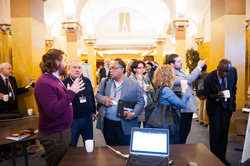CHAIN-REDS paves way for global e-Infrastructure ecosystem for researchers
Aniyan Varghese, Programme Manager with DG CONNECT introduced CHAIN-REDS as a project that ‘has really looked beyond the borders’. And the wide reach of this ambitious initiative was well-reflected in the array of international organisations represented at the conference in Brussels – from the Emeritus Research Centre Johannesburg and Anna University in Chennai to Buenos Aires University and the Chinese Academy of Sciences. Participants discussed the benefits of e-infrastructures for research and education, their vision on long-term global collaboration as well as their experience in using CHAIN-REDS solutions across various disciplines and environments. The ultimate aim of CHAIN-REDS, which began in December 2012 and is coordinated by the National Institute for Nuclear Physics (INFN) in Italy, is to define a path towards a global e-Infrastructure ecosystem that will allow Virtual Research Communities (VRCs), research groups and even single researchers to access and efficiently use worldwide distributed resources covering computing, storage, data, services, tools, and applications. As the project enters its final few months, the CHAIN-REDS team reflected on the achievements and challenges encountered so far. Over the course of the past two and a half years, CHAIN-REDS has directly facilitated the signing of four Memoranda of Understanding (MoUs) to define a framework for collaboration between European Grid Infrastructure (EGI) and Regional Operation Centres (ROCs) in Africa and Arabia, China, India and Latin America. The project also conducted use cases, one of which involved the African Population and Health Research Center (APHRC) in Nairobi, Kenya. Speaking at the conference, Cheikh Faye, Senior Researcher Officer at APHRC, spoke about how CHAIN-REDS supported the centre in implementing a system using Digital Object Identifiers (DOI) and citations metadata for its research: ‘CHAIN-REDS proposed solutions that fit with APHRC open data needs and helped us to document 57 % of our studies. This had a big impact on discoverability.’ The APHRC system has now racked up about 80 000 views. According to Faye, after CHAIN-REDS got involved, the number of views almost doubled. Additionally, the team has promoted the creation of EU-area-specific Science Gateways (SGs) such as agINFRA’s, DCH-RP’s, EarthServer’s, eI4Africa’s and of national SGs in Algeria, Jordan, Italy, Mexico, Morocco and South Africa. At the conference, Ouafa Bentaleb, Grid Administrator from CERIST, the Algerian Research Network, spoke about how her network has been using the SG infrastructure. Specifically, she elaborated on a calculation code called ABINIT which has been integrated into the Algerian SG to assist physicists from about six universities in their calculations related to the structural, electronic and optical properties of materials. The project team has also built up a formidable Knowledge Base available on the project website. Providing information on the e-Infrastructures available around the world, it indirectly covers over 30 million resources and includes about 2 500 Open Access Document Repositories (OADRs) and 600 Data Repositories (DRs). One repository which has been integrated in the CHAIN-REDS Knowledge Base is LAGO - the Latin America Giant Observatory. Sergio Dasso, Professor of Physics at Buenos Aires University in Argentina, spoke about how CHAIN-REDS has helped LAGO to improve its performance in terms of managing massive amounts of data. The next steps for the CHAIN-REDS team are to further promote the project results, solutions and tools in five focus regions (Africa, Arabia, China, India and Latin America) and in Europe, and to continue advocating for policies that enhance global cooperation in digital and open science. For further information, please visit: CHAIN-REDS https://www.chain-project.eu/home
Countries
Italy



